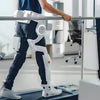The Evolution of Industrial Automation and the Rise of TOF Technology

With the advancement of Industry 4.0 and the widespread adoption of smart manufacturing, industrial automation is undergoing a significant transformation. Businesses are integrating robotics, AI, and IoT to enhance efficiency, reduce operational costs, and ensure product quality. At the heart of this transformation is sensor technology, which plays a crucial role in improving the accuracy, speed, and intelligence of automation systems.
Among various sensor technologies, TOF (Time of Flight) technology has gained prominence due to its high-precision distance measurement and real-time 3D imaging capabilities. TOF sensors are now widely applied in robot navigation, machine vision, logistics management, and industrial safety monitoring, significantly enhancing the level of automation across industries.
Understanding Industrial Automation
What is meant by industrial automation?
Industrial automation refers to the implementation of robots, AI-driven control systems, and intelligent sensors to perform tasks traditionally handled by humans. This reduces manual labor while increasing productivity, accuracy, and safety. Automation technologies are applied in multiple industrial settings, including:
- Smart factories with fully automated production lines
- Robotic arms performing high-precision assembly tasks
- AI-driven quality inspection improving defect detection rates
- Autonomous warehouse systems streamlining logistics and inventory
The goal of industrial automation is to create an intelligent and self-optimizing production environment where machines can analyze, learn, and optimize their performance in real time.
How TOF Technology Works and Its Advantages
Working Principle of TOF Technology
TOF sensors function by emitting infrared or laser light pulses and measuring the time it takes for the light to reflect back after hitting an object. This time delay is then used to calculate the distance and shape of the object, generating precise 3D depth maps of the surrounding environment.
Compared to ultrasonic, structured light, and traditional LiDAR sensors, TOF technology offers faster, more accurate, and more reliable measurements, making it a key enabler of next-generation industrial automation.
Key Benefits of TOF Technology in Industrial Automation
1. High-Precision Measurement
TOF sensors achieve millimeter-level or even micron-level accuracy, making them ideal for applications in precision manufacturing, electronic assembly, and 3D inspection.
For instance:
- Semiconductor industry: TOF sensors are used in wafer inspection to ensure microchip dimensions meet strict specifications.
- Precision machining: They provide real-time error detection to prevent defective production.
- Automotive industry: TOF-based 3D scanning ensures precise alignment of body panels and engine components.
2. Fast Response Time for Real-Time Applications
Since TOF technology operates at the speed of light, it provides nanosecond-level measurement speed, making it perfect for high-speed production lines.
For example:
- In smart factories, TOF sensors track products moving on conveyor belts, allowing robotic arms to adjust operations dynamically.
- In logistics automation, TOF-enabled sorting machines rapidly scan and categorize parcels, ensuring faster processing.
3. Non-Contact Sensing for Delicate Objects
Unlike mechanical or contact-based measuring systems, TOF sensors do not physically touch objects, preventing damage to fragile materials.
Use cases include:
- Electronic assembly: TOF ensures circuit board components are placed accurately without risk of damage.
- Food safety: Non-contact packaging inspection prevents contamination.
- Art and cultural heritage preservation: TOF technology is used for 3D scanning of artifacts without causing degradation.
4. Environmental Adaptability in Challenging Conditions
Unlike structured light sensors, TOF performs well under varying lighting conditions, making it useful for outdoor automation, industrial monitoring, and autonomous navigation.
For example:
- In smart agriculture, TOF sensors enable unmanned tractors to navigate fields in bright daylight or darkness.
- In construction, TOF assists in 3D terrain mapping for excavation and structural planning.
5. AI and IoT Integration for Intelligent Automation
TOF technology can be combined with AI algorithms and IoT networks, enabling real-time environmental perception, object recognition, and predictive analytics.
- AI-enhanced robots: TOF sensors improve AI-driven object tracking and decision-making.
- IoT-enabled factories: TOF systems communicate with cloud-based automation platforms to optimize workflows.
Key Applications of TOF Technology in Industrial Automation
1. Robot Navigation and Obstacle Avoidance
Industrial robots must navigate dynamic environments while avoiding obstacles. TOF sensors help robots perform:
- Accurate path planning using real-time 3D depth data
- Human detection and collision prevention for workplace safety
- Autonomous warehouse operations in logistics centers
In smart factories, AGVs (Automated Guided Vehicles) and AMRs (Autonomous Mobile Robots) use TOF sensors for high-precision obstacle avoidance and environment mapping.
2. 3D Vision for Automated Quality Inspection
Traditional 2D camera systems lack depth perception, leading to inspection errors. TOF-based 3D imaging enhances machine vision for:
- Solder joint inspection in electronics manufacturing
- Surface defect detection in automotive body panels
- Seal integrity checks in food and pharmaceutical packaging
3. Intelligent Sorting and Logistics Optimization
TOF sensors enable automated sorting systems to process packages based on size, shape, and volume.
Applications include:
- Parcel sorting in e-commerce warehouses
- Automated picking and shelving in smart storage systems
- Drone-based inventory scanning for real-time warehouse tracking
4. Industrial Safety and Environmental Monitoring
TOF-based virtual safety barriers detect unauthorized human presence in hazardous zones, preventing workplace accidents.
- In manufacturing plants, TOF sensors monitor employee proximity to dangerous machinery.
- In chemical plants, TOF sensors assist in detecting gas leaks, smoke, or temperature fluctuations.
Future Trends of TOF Technology in Industrial Automation
1. AI-Driven Smart Automation
Future TOF systems will integrate deep learning algorithms, enhancing:
- Predictive maintenance for industrial machines
- Self-learning robots capable of adapting to new environments
- Autonomous decision-making in smart factories
2. 5G and Edge Computing for Real-Time TOF Processing
- 5G networks enable real-time cloud data transfer, improving remote monitoring.
- Edge computing allows local processing of TOF data, reducing latency and improving system response times.
3. Miniaturization and Cost Reduction
- Advances in semiconductor technology will lead to smaller, more affordable, and energy-efficient TOF sensors.
- Widespread adoption will make TOF a standard component in industrial automation systems.
Conclusion
TOF technology is playing an increasingly critical role in industrial automation, offering high-speed, high-precision 3D sensing for applications such as robot navigation, machine vision, logistics, and safety monitoring.
As AI, IoT, and 5G continue to evolve, TOF sensors will become more powerful, intelligent, and cost-effective, shaping the future of smart manufacturing. Businesses that embrace TOF-powered automation will gain a competitive edge, driving the industrial sector toward greater efficiency, precision, and intelligence.
Vzense DS86 & DS87 ToF 3D Cameras - Industrial Grade, High Precision,5m1600*1200

After-sales Service: Our professional technical support team specializes in TOF camera technology and is always ready to assist you. If you encounter any issues during the usage of your product after purchase or have any questions about TOF technology, feel free to contact us at any time. We are committed to providing high-quality after-sales service to ensure a smooth and worry-free user experience, allowing you to feel confident and satisfied both with your purchase and during product use.
-
Posted in
DS86 & DS87






